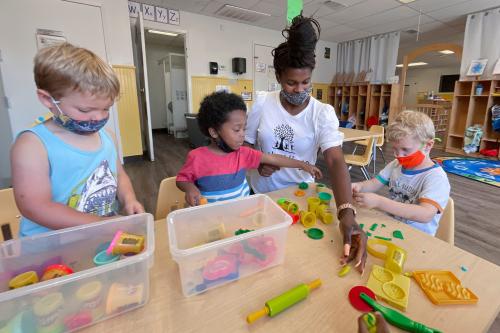School teachers have dominated news headlines in the past month. On the heels of the omicron variant surge, many teachers, parents, and school leaders are exhausted. Whether it is adapting on the fly to new safety protocols, finding child care when schools close due to COVID-19 outbreaks or inclement weather, growing external pressure about what should be taught in public schools (and how), or simply finding time to rest and recharge in year two of a seemingly relentless pandemic, everyone involved in the care and education of children is stressed. Teaching has long been a uniquely challenging profession to be sure; the recent perfect storm of a pandemic, an increasingly hostile and partisan political climate, and a general reckoning of racial injustice have only amplified those challenges.
All of this has led to widespread concern of a mass exodus from the profession. So far, most of the concern is based on anecdotes and survey results about teachers’ plans for the future and not actual attrition from the profession. Still, persistent teacher shortages in certain subjects and locations are very real, as are newly acute shortages of support staff and substitute teachers. Apropos of February being Black History Month and that many Black and other communities of color have been disproportionately harmed by the pandemic, there’s also a severe—and longstanding—shortage of Black teachers in this country.
As states and districts across the country discuss how to recruit and retain an effective teaching force and begin to prepare for the next school year, they should prioritize having a teaching force that’s representative of the broader demographics of public school students in the United States. For reference, just over 50% of students are from nonwhite racial and ethnic backgrounds, compared to roughly 20% of teachers. The current situation—in which schools are flush with federal funds and are developing strategies for pandemic recovery—provides an opportunity to diversify the teaching force that is simply too good to pass up.
To make good on this opportunity, we must re-conceptualize diversity and representativeness as two of the many attributes that contribute to the quality of the teaching force. This simple idea is the thesis of our book, “Teacher Diversity and Student Success,” which is now available from Harvard Education Press. In the book, we make several arguments about why it’s imperative to do a better job of recruiting and retaining a diverse and representative teaching force—the urgency of which has only grown in the wake of the pandemic.
- Teachers of color make a lasting impact on students of color. Rigorous evidence from many contexts shows that teachers of color improve student outcomes—both in the short term (including test scores and suspensions) and long term (including high school graduation and college aspirations). In the pandemic, students of color have had less access to in-person learning and have fallen even further behind their white peers. Providing access to quality and diverse teaching can be just as important a tool for learning recovery as tutoring or summer school.
- Teachers of color help build a representative school bureaucracy. Teachers of color become leaders of color, and schools and districts with more representative workforce and leadership are associated with smaller gaps in test scores and more parent engagement among communities of color. More representative leadership will be key to ensuring that pandemic recovery funds are targeted to the communities that have been harmed most in recent years.
- Teachers of color help promote tolerance among all students. Exposure to a racially and ethnically diverse set of teachers will help all students—regardless of their own background—cooperate with and recognize the humanity in people from backgrounds different from their own. Seeing other groups of people as allies—not threats—is a character skill needed now more than ever after a pandemic that has further reinforced attitudes already polarized by party and race.
We agree with the many advocacy groups, school systems, and government agencies that have issued calls for increasing educator diversity in recent years. But our call is unique in that it’s about more than numbers. We see increased racial representation among the teacher workforce as a necessary, but not sufficient, condition for school success.
We also argue for policies that promote a greater integration of teachers across school contexts to ensure all students have access to diverse teachers and for policies that help the majority of teachers who are white to more effectively reach the students of color in their classrooms. These additional objectives are critical; otherwise calls for teacher diversity could inadvertently become a trojan horse leading to segregated teachers for segregated schools.
Consequently, we urge policymakers and school leaders to be strategic about how they go about promoting teacher diversity across the workforce. There is a menu of policy options that we should be pursuing across many levels of government to help promote the number and status of individuals of color in public schools and to ensure that all students have access to an array of teachers who are representative of the increasingly diverse country they live in. These options include things like offering more generous federal loan forgiveness policies for teachers, re-examining state policies regarding teacher licensure, and adopting practices that promote more diverse hiring pools at the local level. School systems should track students’ exposures to diverse teachers and teacher training programs should seek to provide candidates with student teaching experiences in diverse settings.
Naturally, the best set of policies is going to vary based on local needs, but everybody working to support our schools can and should be doing something to promote schools as safe places for teachers and students of color. Whether it’s grow-your-own programs in rural areas or teacher residencies for mid-career switchers in urban settings, all efforts can collectively move the needle on this urgent policy goal. Places without a robust stock of diverse talent in their schools may need to get creative; be careful not to overlook paraprofessionals, substitute teachers, coaches, and afterschool club leaders. With evidence showing that even a single exposure to a role model in career-day presentations can help students reimagine their futures, no effort is too small to leave off the table.
Only with intentional and sustained focus on diversity and representativeness can we really ensure that all students have equal access to quality teaching that allows them, and our country, to reach their full potential. We should use the opportunity afforded by increased federal funding to make paradigm-shifting progress on the ways in which schools reflect our diversity. Having a diverse and representative teaching force will enable every month to be Black History Month, as Black history is American history and can’t be overlooked or shoehorned into a specific subset of the curriculum. Having a racially and ethnically diverse and representative teaching force will ensure that students’ diverse backgrounds and experiences are valued, respected, and utilized in the classroom to produce positive outcomes for all students.









Commentary
Prioritize educator diversity to address racial injustices
February 28, 2022